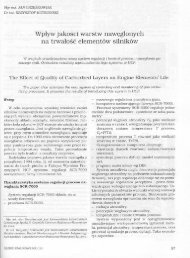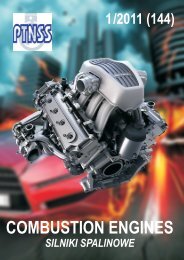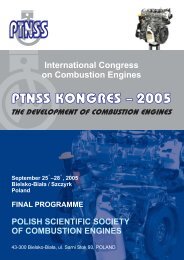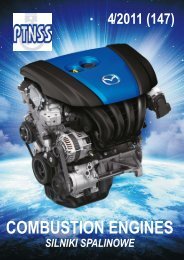You also want an ePaper? Increase the reach of your titles
YUMPU automatically turns print PDFs into web optimized ePapers that Google loves.
Źródła zanieczyszczeń i uszkodzeń części przepływowej okrętowego turbinowego...<br />
2Na 2<br />
SO 4<br />
+ 2H 2<br />
O → 2H 2<br />
SO 4<br />
+ 2Na 2<br />
O (3)<br />
Moreover, during the mutual reaction of the forming<br />
chlorides of the alkaline elements (vanadium, sodium and<br />
potassium contained in the<br />
fuel) and the sulfur compounds<br />
at high temperatures<br />
around 1050 K pyrosulfates<br />
and tri-sulfates<br />
are formed that are highly<br />
corrosive to the protective<br />
metal oxide layers (high<br />
temperature corrosion) –<br />
Fig. 5 [11, 12].<br />
The chemically active<br />
substances moving<br />
along the flow part of the<br />
engine disintegrate the<br />
protective layer of the<br />
engine structure. Damage<br />
of the protective alloy<br />
layer based on aluminum,<br />
nickel or cobalt begins<br />
from the formation of<br />
local corrosion spots (sulfur<br />
oxides and vanadium<br />
oxides) gradually finding<br />
their way inside the<br />
layer. For example for<br />
the material of the turbine<br />
vanes coated with the<br />
aluminum-nickel-cobalt protective layer, the presence of<br />
particles of vanadium and sulfur in the fuel results in a<br />
formation of complex compounds such as oxides, sulfides<br />
and vanadates. They occur as fusible mixtures depositing<br />
powłoki ochronnej, wykonanej ze stopów na osnowie aluminium,<br />
niklu lub kobaltu, rozpoczyna się od powstawania<br />
lokalnych ognisk korozyjnych (tlenków siarki i tlenków<br />
wanadu), systematycznie przenikających w głąb powłoki. Na<br />
Fig. 5. Characteristic high temperature corrosion bubbles on the guide vanes of the high pressure turbine of the<br />
Zorya DE59 engine<br />
Rys. 5. Charakterystyczne pęcherze korozji wysokotemperaturowej na łopatkach kierowniczych turbiny wysokiego<br />
ciśnienia silnika Zorya typu DE59<br />
przykład dla materiału łopatek turbin z aluminiowo-niklowokobaltową<br />
powłoką ochronną obecność w paliwie cząsteczek<br />
wanadu i siarki skutkuje w wyniku spalania tworzeniem się<br />
złożonych związków chemicznych typu tlenków, siarczków<br />
Fig. 6. The mechanism of formation and development of the corrosion of the protective layer of a turbine vane in the Zorya UGT engines<br />
Rys. 6. Mechanizm powstawania i rozwoju korozji powłoki ochronnej łopatek turbin w silnikach Zorya typu UGT<br />
14 <strong>COMBUSTION</strong> <strong>ENGINES</strong>, No. 4/2012 (151)












